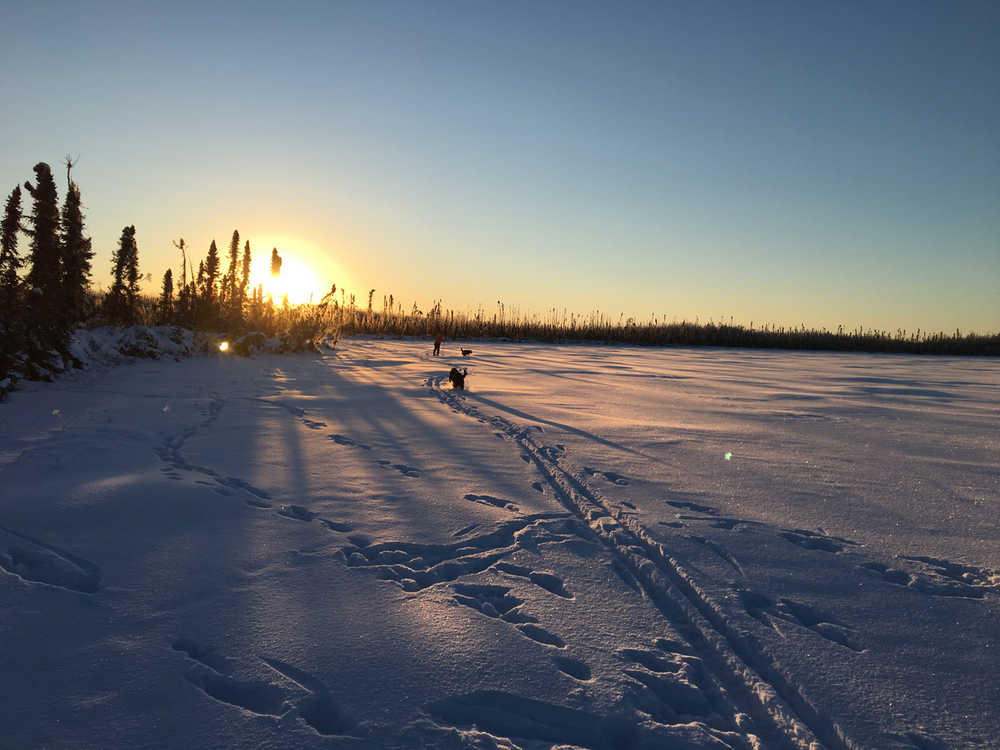Yay! We’re two days past the Winter Solstice, our longest night, headed in the right direction for day length. Good days of skiing and ice-fishing are ahead of us and eventually the birch sap will run, the snow geese will return and our gardens will grow.
Although we called this past Dec. 21 the Winter Solstice, only for a brief moment at 1:44 a.m. Alaska Time did the sun actually “reach” its southern-most extent at the Tropic of Capricorn, where it was directly overhead at 23°26’13.5”. At that instant, the sun “stood still” before the earth’s 23.5 degree celestial tilt and its 365-day rotation around the sun made it seem (to those of us standing on earth) that the sun was finally headed back north. And so we call this day the solstice, which means in Latin “to make the sun stand.”
As the earth continues rotating around the sun, the sun will be directly over the equator on March 20, 2017, an event we call the spring equinox. On June 20, 2017, the sun will reach its northern-most extent, perching briefly over the Tropic of Cancer. At that moment, any part of earth north of the Arctic Circle, which we call the Arctic, will experience at least one 24-hour period of daylight. In other words, the sun is still above the horizon at midnight — hence, the land of the midnight sun.
You can visit a sign at a rest area on the Dalton Highway, 59 miles north of the Yukon River, which marks the Arctic Circle. What’s kind of cool about the Arctic Circle is that unlike the Equator, it is not a fixed position. Currently it runs 66°33’46.5” north of the Equator, but it is drifting northwards almost 50 feet per year due to fluctuations in the earth’s axial tilt.
But on our longest night of the year, just before Christmas, you can bet that brown and black bears are deep in their dens, even as children are nestled all snug in their beds. With less than 5 1/2 hours of daylight, marmots are deep in hibernation, the chickadees are hitting the bird feeders, and the moose stay close to their winter browse. Native evergreens like spruce, hemlock, juniper, lingonberry, crowberry, and clubmoss continue to do their best to photosynthesize in the waning light, but most plants have senesced, dropping their leaves back in the fall.
Watch, though, as the sun returns to the northern hemisphere over the next few weeks, even the next few days. It doesn’t take long for our resident wildlife like bald eagles to become more vocal and active, putzing around last year’s nest. Great horned owls start belting out their mating hoots in February.
Consider that many of our birds that migrate far to the south are having the time of their lives as we finish up our holiday shopping in crowded stores. It’s easy to forget that migratory birds which breed in the high arctic and subarctic spend most of their year in warmer climates. Todd Eskelin, a biologist at the Kenai National Wildlife Refuge, sighted a migrating semipalmated sandpiper at the mouth of the Kenai River that was originally banded on the beaches of Ecuador during winter. Aleutian terns, which nest in the wetlands surrounding Headquarters Lake behind the Kenai Refuge Visitor Center, are likely frolicking in the warm waters off Indonesia or Malaysia as we slept through the recent solstice.
What drives the birds to leave, and eventually return, is their innate response to the changing photoperiod, which is an artifact of the earth’s tilted axis. And you might guess that the closer to the North Pole (or South Pole) that a species breeds, the more responsive it needs to be to changing sunlight simply because there is so little time to get all that needs to be done to successfully reproduce and mature.
I read with great interest a 2009 paper published in the Journal of Fish Biology that examined precisely that question in three-spined sticklebacks, a fish common in lakes on the Kenai Lowlands. Researchers from the University of Oregon challenged sticklebacks caught in Anchorage and in Oregon with different photoperiods under climate-controlled laboratory conditions. Sure enough, reproductive maturation was strongly affected by day length for male and female sticklebacks from Alaska, but not from Oregon.
So, be glad the earth is tilted in its celestial plane, be glad that the sun was over the Tropic of Capricorn a few days ago, be glad for longer days and be glad that the birds know this, too. All glad tidings as we settle into the Christmas weekend!
Dr. John Morton is the supervisory biologist at Kenai National Wildlife Refuge. Find more information about the refuge at http://www.fws.gov/refuge/kenai/ or http://www.facebook.com/kenainationalwildliferefuge.

